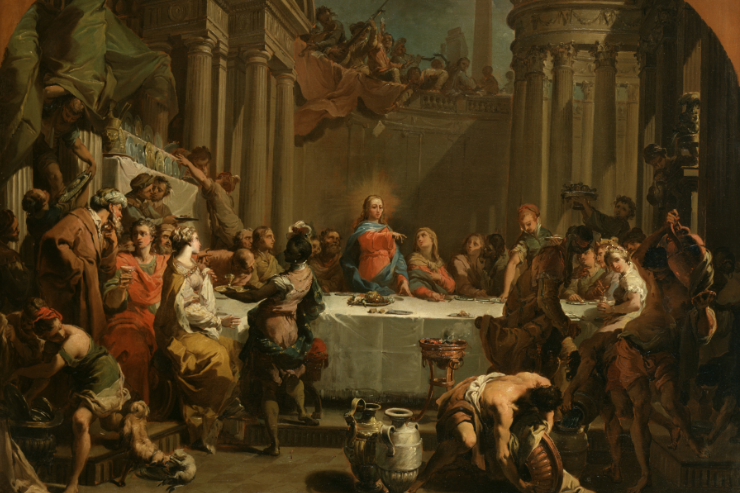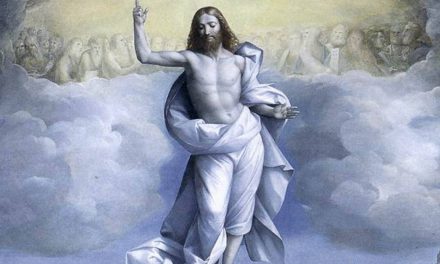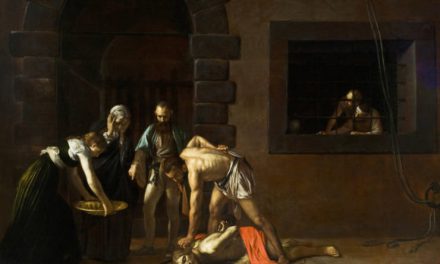
“The Marriage at Cana” by Gaetano Gandolfi [Public domain], via Wikimedia Commons
There have been many famous weddings in history, but I would argue that none more so than the Wedding Feast at Cana.
This vignette in the life of Jesus is found in John’s Gospel and is traditionally held to record his first miracle – what John refers to as “the beginning of his signs.” We can better understand the importance and lessons of this story and sign by looking at its setting and characters.
Setting
First, there is the wedding itself. In the first century, a Jewish wedding celebration would last days – the wealthier the couple, the longer the celebration. The couple would want to be generous hosts as hospitality was keenly important to the Jews and other people of this cultural time and place.
Second, there is the story’s place in John’s Gospel. The opening chapters of this Gospel present imagery of a new creation account. The Word – that is the Second Person of the Blessed Trinity – through whom everything was made at the time of creation has come among us and taken on a human nature to redeem and heal creation – making all things new again. We know the Word Made Flesh is Jesus. John positions the telling of the Wedding at Cana on the seventh day of this new creation account. This points us back to the original creation account and the first gospel proclamation in opening chapters of Genesis.
Characters
Now, let’s identify the principal characters. First, of course, is Mary and Jesus, then the servants, headwaiter and the groom.
We don’t even know who the identity of the happy couple, but their wedding feast was attended by the most important guests ever – Jesus, Mary his mother, and his closest disciples.
The Dialog Between Mother and Son
We learn that the wine has run out before the celebration has ended. This would be a highly embarrassing failure in hospitality by the couple that would mar the beginning of their public married life. Mary, who in all probability was helping with the feast, saw that they had run out of wine and spoke to Jesus, implicitly asking him to miraculously provide more wine.
I want you to close your eyes and imagine the dialog between mother and son. The text does not provide us any explicit description of their manner or tone. But you and I know their deep love and respect for each other.
Mary approaches her son and says, “They have no wine.” Jesus replies, “Woman, how does your concern affect me? My hour has not yet come.”
While it is unusual for a son to refer to his mother as “woman,” such a label is not disrespectful. Given that the setting in the gospel points to Genesis, the use of “woman” also points to the woman of Genesis in Genesis 3:15. The first Eve chose self over God, but Mary, the New Eve, chooses God in all things and always points the way to her son.
The first part of Jesus’ reply to Mary is a Hebrew idiom meaning, “What does this concern have to do with you and me?” The “hour” to which Jesus refers is his defeat of Satan by his Passion and Sacrifice on the Cross.
Mary is intimately involved in her son’s redemptive mission and work. This dialog can be understood as a tender exchange between Jesus and Mary where the Lord asks Mary if she understands and is ready for what will follow this first public sign of the Divine Messiah.
Mary’s response is to instruct the servants to do whatever Jesus tells them reveals that she understands and will continue to say yes to God.
Jesus’s response is to do what his mother asked of him.
The First Sign
There were six stone jars present that were used for ritual purification and handwashing. Together they could hold well over one hundred gallons of water. Jesus instructs the servants to fill them and draw some out to take to the headwaiter.
Imagine this scene. These jars would ordinarily contain “lustral” waters for purification – that is water mixed with the ashes of burnt animal offerings. This water would be sprinkled on one who is ritually unclean as part of this ceremonial purification.
Yet the servants obey Mary, and do exactly what Jesus instructed, taking the water they drew from the jars to the headwaiter. Imagine their surprise and relief when the headwaiter discovered that this was the very best of wine and available in abundance, even after so much wine had been served earlier!
What Can We Learn?
There are a number of important lessons we should take from this account. Here are just a few.
- Mary Points the Way to the Lord– Many saints have taught that the surest way to Jesus is through Mary. The scriptures present Mary at significant moments of the Lord’s work of redemption, always presenting God to us and directing us to God.
Mary said yes to God at the Annunciation when Gabriel appeared to her.
Mary presented the unborn Jesus to Elizabeth and the unborn John the Baptist at the Visitation.
Mary presented the Lord to the shepherds at the manger, to Simeon, Anna and the Father at the Presentation, to the Magi at Bethlehem.
She presents Jesus to the servants and guests at the Wedding Feast at Cana and to all of us.
Mary will be present at the Cross and later in the Upper Room at Pentecost.
And she is present in the New Jerusalem as the New Ark of the Covenant.
- Our Spiritual Mother– Jesus gave Mary to us all from the Cross. Her role as our spiritual Mother pointing us to Christ is accompanied by the grace to do what her son instructs. The servants at Cana, in spite of the unusual instruction took what they must have believed to be dirty water to the headwaiter; they did exactly what he said and were amazed! Of course we can ignore Mary and go directly to Jesus, but this passage show us that Mary always cares for her spiritual children and takes them to the Lord who said yes to her and obviously want us to know that by including this passage in the bible.
- Sacraments of the New Covenant– In a broader context, John’s Gospel is structured around a series of signs that indicate the passing of the ceremonial rites of the Old Covenant and the sacramental rites of the New Covenant.
In this one sign, we see the Sacrament of Baptism replacing the lustral waters of the Jewish purification rite.
In the wine, we see the super abundance of grace and Divine Presence in the Sacrament of the Eucharist. We see this unique presence of the Lord on the Altar at Holy Mass.
And it is no accident that this takes place at a marriage celebration – the bridegroom and bride being a principal scriptural image of God’s relationship and love for his people. As the Lord sanctified the family by entering creation within a family, he now sanctifies Holy Marriage by working his first public sign at a wedding.
Our Lives Are Gifts
We are loved by God. Everything we learn from the whole of Scripture and from personal experience living the Sacramental life reveals his love for each of us… for you and for me.
Our very lives are gifts to us from the Creator. We come from Him. We are called to journey in this life as we prepare for our eternal home with him. We belong to Him. He wants all good things for us in abundance.
This Tuesday, January 22, will mark forty-six years since the U.S. Supreme Court legalized abortion. Countless lives have been ended before they were born as a result.
We pray for these children and for those who chose abortion. God’s love can overcome and heal all wounds.
We must never treat this threat on the unborn with indifference so we must work and pray for an end to abortion.
The Mass readings for the Second Sunday in Ordinary Time (Year C) — Isaiah 62:1-5; Psalms 96:1-2, 2-3, 7-8, 9-10; First Corinthians 12:4-11; John 2:1-12.
Into the deep…
Deacon Bickerstaff is available to speak at your parish or event. Be sure to check out his Speaker Page to learn more. Into the Deep is a regular feature of the The Integrated Catholic Life™.
Come and Join me on Twitter!














